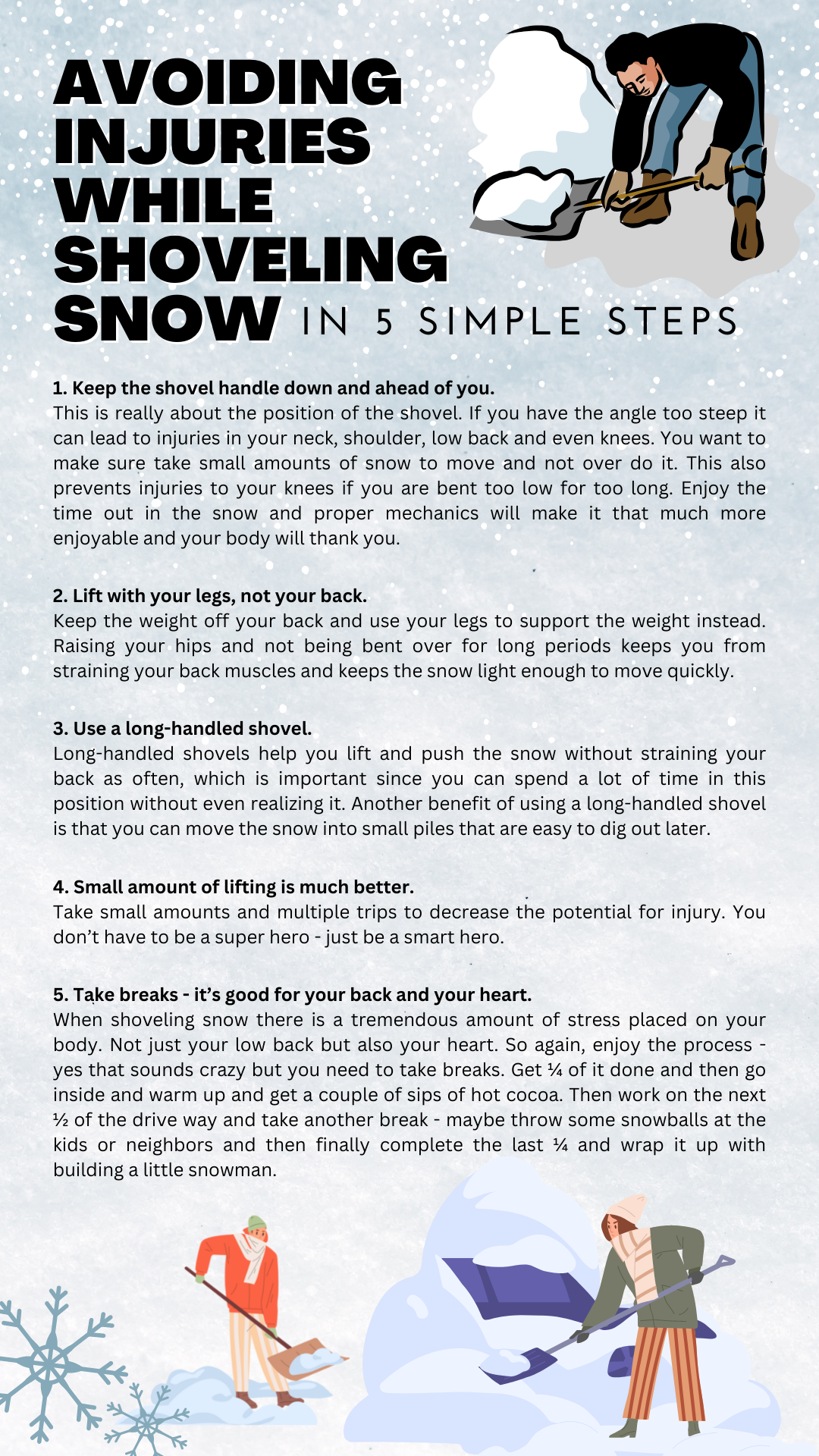
- Keep the shovel handle down and ahead of you. This is really about the position of the shovel. If you have the angle too steep it can lead to injuries in your neck, shoulder, low back, and even knees. You want to make sure to take small amounts of snow to move and not overdo it. This also prevents injuries to your knees if you are bent too low for too long. Enjoy the time out in the snow and proper mechanics will make it that much more enjoyable and your body will thank you.
- Lift with your legs, not your back to avoid common snow shoveling injuries. Keep the weight off your back and use your legs to support the weight instead. Raising your hips and not being bent over for long periods keeps you from straining your back muscles and keeps the snow light enough to move quickly.
- Use a long-handled shovel. Long-handled shovels help you lift and push the snow without straining your back as often, which is important since you can spend a lot of time in this position without even realizing it. Another benefit of using a long-handled shovel is that you can move the snow into small piles that are easy to dig out later.
- A small amount of lifting is much better for avoiding snow shoveling injuries. Take small amounts and multiple trips to decrease the potential for injury. You don’t have to be a superhero – just be a smart hero.
- Take breaks – it’s good for your back and your heart. It is also helpful for avoiding snow-related injuries. When shoveling snow there is a tremendous amount of stress placed on your body. Not just your low back but also your heart. So again, enjoy the process -yes that sounds crazy but you need to take breaks. Get % of it done and then go inside and warm up and get a couple of sips of hot cocoa. Then work on the next 1/2 of the driveway and take another break – maybe throw some snowballs at the kids or neighbors and then finally complete the last % and wrap it up with building a little snowman.
HOW TO AVOID SNOW SHOVEL INJURIES
Winter is here and with it comes the inevitable task of shoveling snow. While it may seem like a simple task, snow shoveling can lead to a variety of injuries, particularly to the back. In this blog post, we will be discussing how to avoid snow shovel injuries and tips to help prevent common snow shoveling injuries. We will also be covering snow-related injuries and how to prevent back injuries from shoveling snow. By above 5 simple steps, you can stay safe and injury-free while tackling the winter weather.
-
Understanding the Risks of Back Injury from Shoveling Snow
- Shoveling snow can put a lot of strain on the back, making it one of the most common snow-related injuries.
- People with pre-existing back conditions, such as herniated discs or arthritis, are at a higher risk for injury.
- Using improper technique or lifting heavy loads of snow can also contribute to back injury from shoveling.
- To prevent back injury, it’s important to use the proper technique and to stretch before and after shoveling.
- Wearing appropriate clothing and footwear, and taking regular breaks to rest and stretch, can also help prevent back injury from shoveling snow.
- If you experience pain or discomfort while shoveling, stop immediately and seek medical attention if necessary.
- Remember to be mindful of your physical limitations and to listen to your body, if something feels wrong don’t push yourself too hard.
-
Common Snow Shoveling Injuries and How to Avoid Them
Winter is here and with the snow comes the need to shovel it away. While it may seem like a simple task, snow shoveling can lead to a variety of injuries. In this blog post, we will be discussing the most common snow shoveling injuries and tips on how to avoid them. From strains and sprains to slips and falls, we will cover it all. We will also touch on back injuries from shoveling snow and how to prevent it. By following the above 5 simple steps, you can stay safe and injury-free while tackling the winter weather. Remember that it’s important to be mindful of your physical limitations and to listen to your body. If something feels wrong, don’t push yourself too hard. Stay safe and enjoy the winter season.
